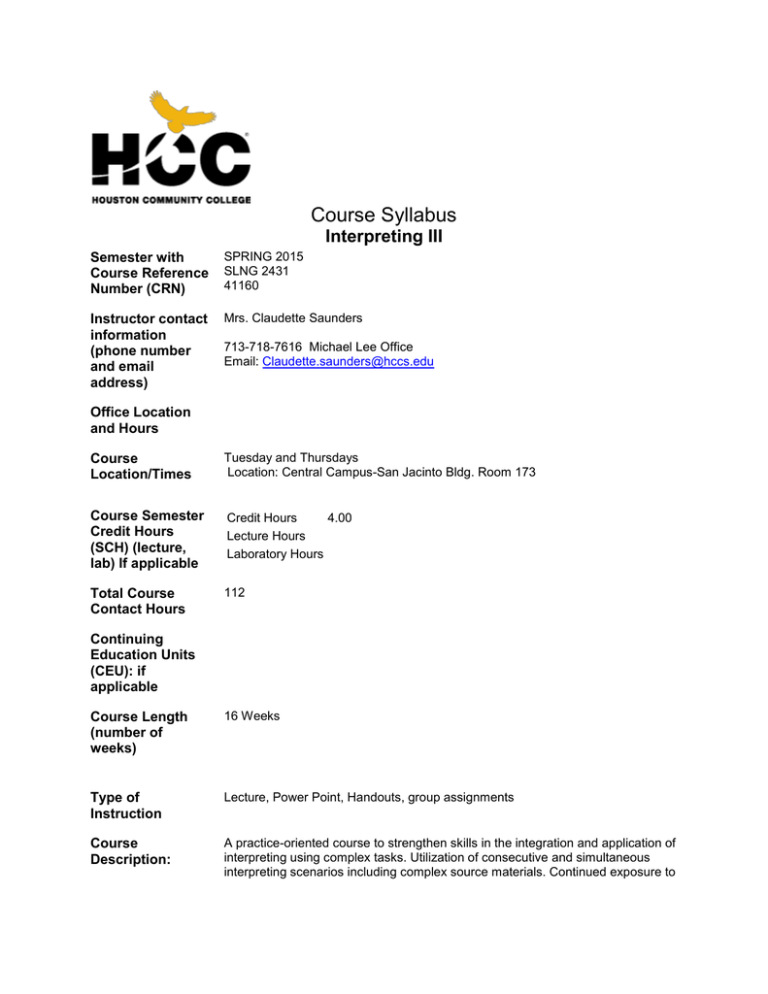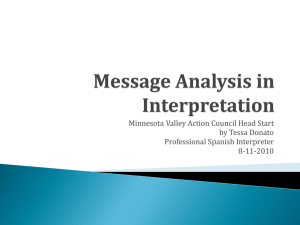
Course Syllabus
Interpreting III
Semester with
Course Reference
Number (CRN)
SPRING 2015
SLNG 2431
41160
Instructor contact
information
(phone number
and email
address)
Mrs. Claudette Saunders
713-718-7616 Michael Lee Office
Email: Claudette.saunders@hccs.edu
Office Location
and Hours
Course
Location/Times
Tuesday and Thursdays
Location: Central Campus-San Jacinto Bldg. Room 173
Course Semester
Credit Hours
(SCH) (lecture,
lab) If applicable
Credit Hours
4.00
Lecture Hours
Laboratory Hours
Total Course
Contact Hours
112
Continuing
Education Units
(CEU): if
applicable
Course Length
(number of
weeks)
16 Weeks
Type of
Instruction
Lecture, Power Point, Handouts, group assignments
Course
Description:
A practice-oriented course to strengthen skills in the integration and application of
interpreting using complex tasks. Utilization of consecutive and simultaneous
interpreting scenarios including complex source materials. Continued exposure to
simulated interpreting/transliterating experiences.
Course
Prerequisite(s)
PREREQUISITE(S):
SLNG 2401
SLNG 2402
Academic
Discipline/CTE
Program Learning
Outcomes
1. Develop receptive and expressive skills in American Sign Language and
Fingerspelling; Develop knowledge and awareness of the differences between
the Deaf culture/deaf community and the hearing community; Accurately interpret
and transliterate between ASL and English in a variety of settings: face-to-face,
small group settings, monologue and/or large group settings; and Apply
professional standards, practices, and ethics, not limited to the tenets of the Code
of Professional Conduct, to their work.
Course Student
Learning
Outcomes (SLO):
4 to 7
1. Demonstrate an understanding of the interpreting process theories and
concepts
2. Interpret intermediate-level material from American Sign Language to Spoken
English in a culturally and linguistically appropriate way
3. Interpret intermediate-level material from Spoken English to American Sign
Language in a culturally and linguistically appropriate way
4. Analyze and evaluate interpreted material
5. Understand the current best practices in the interpreting profession
Learning
Objectives
(Numbering
system should be
linked to SLO e.g., 1.1, 1.2, 1.3,
etc.)
Demonstrate an understanding of the interpreting process theories and
concepts
Interpret intermediate-level material from American Sign Language to
Spoken English in a culturally and linguistically appropriate way
Interpret intermediate-level material from Spoken English to American Sign
Language in a culturally and linguistically appropriate way
Analyze and evaluate interpreted material
Understand the current best practices in the interpreting profession
Learning Outcomes and Performance Objectives/Methods of Measurement
Learning Outcome 1- Students will demonstrate an understanding of the
interpreting process with theories with applied concepts with a minimum of 80%
accuracy.
Performance objectives for this outcome
The student will demonstrate an understanding of the following learning
outcomes:
Theoretical models describing the process of interpreting
Theoretical models of interpreting by using appropriate terminology
Have the understanding of the components of message analysis that
includes
a. primary idea
b. secondary idea
c. details
f. register
d. implicit information
e. affect
Have an understanding of paraphrasing techniques used in the following
a.
b.
c.
d.
lexical
phrasal
sentential
discourse levels
Have an understanding of closure and
anticipatory/prediction skills
Demonstrate semantic chunking at phrasal, sentential,
and discourse level
Demonstrate American Sign Language expansion
techniques, such as contrasting feature, faceting, and
reiterating, using 3-D space.
Demonstrate compression techniques used in voicing
information presented in American Sign Language
Method of Measurement- Written Assignments, Class Discussion
Learning Outcome 2- The student will demonstrate the ability to interpret
material from American Sign Language to Spoken English with a minimum of
80% accuracy.
Performance objectives for this outcome
The student will demonstrate the following skills
Eye/head/body shifting
Reference markers
Non-manual grammatical markers
Non-manual affective markers
Other visual context clues
Identify fingerspelled information
Identify numerical information
Maintain message equivalence from source language to target language
Appropriate physical production of spoken English such as:
a.
b.
c.
d.
e.
pronunciation
articulation
vocal inflection
voice quality
volume
Method of Measurement: Evaluation of cassette recording, DVD recorded
performance, instructor observation and written assignment
Learning Outcome 3- The student will demonstrate the ability to interpret
intermediate-level material from Spoken English to American Sign Language
with a minimum of 80% accuracy.
Performance objectives for this outcome
The student will demonstrate the following skills
Maintain message equivalence from source language to target
language (primary ideas, secondary ideas, transitions, and spirit)
Physical production of signs
(formation, clarity, control, and space)
Physical production of fingerspelling
(formation, clarity and appropriate incorporation)
Physical production of numbers
(formation, clarity, and appropriate incorporation)
Physical production for sign fluency
(pace, rhythm and cadence, pausing, and flow of ideas)
Ability to use grammatical components of American Sign Language
(syntax, complete utterances, non-manual markers, indexing and
referents, spatial elements, classifier usage, and role-shifting)
Method of Measurement: Evaluation of cassette recording, DVD recorded
performance, instructor observation and written assignment
Learning Outcome 4- The student will demonstrate an understanding of
current best practices in the interpreting profession.
Performance objectives for this outcome
The student will demonstrate the following:
Ability to express information appropriately
Exhibit interpersonal skills
Accept and incorporate feedback from self and others
Dress appropriately
Make interpersonal adjustments for difference opinions, learning
styles to interpreting
Ability to work tactfully with a variety of personalities
Method of Measurement: Evaluation of cassette recording, DVD recorded
performance, instructor observation and written assignments.
SCANS and/or
Core Curriculum
Competencies: If
applicable
Instructional
Methods
Student
Assignments
Demonstrate an understanding of the interpreting process theories and
concepts
No assignments selected for this outcome
Interpret intermediate-level material from American Sign Language to
Spoken English in a culturally and linguistically appropriate way
No assignments selected for this outcome
Interpret intermediate-level material from Spoken English to American Sign
Language in a culturally and linguistically appropriate way
No assignments selected for this outcome
Analyze and evaluate interpreted material
No assignments selected for this outcome
Understand the current best practices in the interpreting profession
No assignments selected for this outcome
Student
Assessment(s)
Demonstrate an understanding of the interpreting process theories and
concepts
No assessments selected for this outcome
Interpret intermediate-level material from American Sign Language to
Spoken English in a culturally and linguistically appropriate way
No assessments selected for this outcome
Interpret intermediate-level material from Spoken English to American Sign
Language in a culturally and linguistically appropriate way
No assessments selected for this outcome
Analyze and evaluate interpreted material
No assessments selected for this outcome
Understand the current best practices in the interpreting profession
No assessments selected for this outcome
Instructor's
Requirements
The faculty members of the Interpreter Training Program are committed
to your successful completion of our classes without lowering the
college’s academic standards. I understand that students face additional
pressures from work and family, as well as have other obligations outside
of their academic pursuits. I realize that at times issues beyond the control
of a student interfere with class requirements.
If you experience any circumstance that has a negative impact on your
participation in this course, please make me aware of it as soon as
possible. I may be able to assist or accommodate your particular
circumstance. Do not wait until the end of the semester to ask for advice.
Communication between students and instructors can be quite valuable.
Students are required to silence all electronic devices (e.g., pagers, cellular
phones, etc.) when in classrooms and lab.
Regular and punctual attendance at all classes and laboratories, day and/or
evening, is required. A student absent for any reason is responsible for all
work missed. Both tardiness and early departure from class are forms of
absenteeism. The instructor establishes the policy with regard to each.
Absences of each student are recorded without exception. The counting of
absences begins on the first day of class. A student absent the equivalent of
6 hours of instruction in a 16-week semester may be dropped by the
instructor. If a student is dropped from a class for excessive absences, the
instructor will record a grade of “W’ (withdraw). It is the student’s
responsibility to ensure that the withdrawals have been submitted.
Program/Disciplin Global Awareness
e Requirements: If
This class will encourage an understanding of the importance of diversity and
applicable
difference in the college, the community, and the country.
HCC Grading
Scale
A = 100- 90
B = 89 - 80:
C = 79 - 70:
69 and below = F
W(Withdrawn)
I (Incomplete)
4 points per semester hour
3 points per semester hour
2 points per semester hour
0 points per semester hour
0 points per semester hour
0 points per semester hour
To compute grade point average (GPA), divide the total grade points by the total
number of semester hours attempted. The grades “I" do not affect GPA.
Instructor Grading
Criteria
GRADING:
Your grade will be
determined by the
following
Class
Assignment/Homework
Workshops
Quizzes
Mid-Term/Final Exam
Details
BAITS
assignments,
Self video and
Analysis,
group project,
peer reviews,
Portfolio, and
etc.
Must attend 2
workshop –
prior approval
from instructor
10 quizzes
Expressive and
Performance
Total:
NOTE: All homework assignments are due at
the beginning of class, if turned in late, 15
points will be deducted.
Instructional
Materials
Percent
of Final
Average
30.0%
10.0%
10.0%
50.0%
100.00%
Flip video camera/recording device
Building ASL Interpreting and Translation Skills: Narratives for Practice
by N. Sheetz, (2009) Pearson Longman
Journal
GoReact.com ($15 Dollars)
USB Flash Drive
.
Portfolio
HCC Policy Statement:
Access Student
Services Policies
on their Web site:
http://hccs.edu/student-rights
Distance Education and/or Continuing Education Policies
Access DE
Policies on their
Web site:
http://de.hccs.edu/Distance_Ed/DE_Home/faculty_resources/PDFs/DE_Syllabus.
pdf
Access CE
Policies on their
Web site:
http://hccs.edu/CE-student-guidelines


